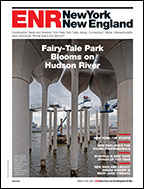Despite the economic downturn, Baker Roofing Co. is reaching new heights, literally and figuratively, as it ventures into new market sectors and broadens its reach in the Southeast. The Raleigh-based company, 96 years in the roofing business, is moving into renewable energy markets. Baker continues to focus on its home Southeast turf, but it is expanding into more cities in the region.
The strategies have paid off. Although its profit margins are down, Baker's regional revenue climbed a strong 29% last year, to $117.1 million. The company has also maintained its work force at more than 750 during tough economic times. For its successful strategy and other reasons, ENR Southeast has named Baker Roofing its Specialty Contractor of the Year.
Baker has deep roots in roofing, reaching back to 1915, when founder W.P. Baker opened Baker Rawls Tin Shop in downtown Raleigh. He hung a sign in the shop that read, “We shall do good work. At a profit if we can, at a loss if we must, but always good work.”
The sign still hangs in the company's headquarters as a reminder of the family-owned firm's values. Lately, Baker Roofing is finding that “good work” can be done in new fields.
The prime example is renewable energy, including solar and wind power. Knowing that roofs are where solar panels often go, Baker saw an opportunity to launch a new line of business.
Some other roofing contractors do renewable-energy projects, but Baker decided to make a major commitment. In 2009 it formed a separate Baker Renewable Energy division to specialize in that market. It is a full-service, engineering procurement contractor providing integrated services for solar photovoltaic, solar thermal and wind projects for general contractors, building or system owners, and utilities in North and South America.
“We tried to expand where we would go to do that kind of work,” says John Matthews, Baker Roofing's executive vice president and president of the renewable-energy division. “The jobs are, typically, of shorter duration, so you can go somewhere for two to three weeks, install a system and be home.”
Matthews says Baker also recognized that owners wanted one contractor to install both the roof and the energy equipment.
Company officials learned as much as they could about renewable energy and then hired specialists in energy and electrical integration. “We did not try to convert rooftop folks into managing electrical projects,” says Matthews, though he adds that Baker did retrain some of its labor force to perform renewable-energy installations.
John Wilkins, vice president of operations for RN Rouse, a general contractor in Goldsboro, N.C., praises Baker's staff for their competence in the renewables market and in sustainable design. RN Rouse has included Baker officials in its presentations to clients who are seeking Leadership in Energy and Environmental Design certification or renewable features. “Baker is on the leading edge of that technology,” Wilkins says.






